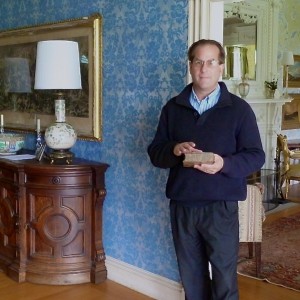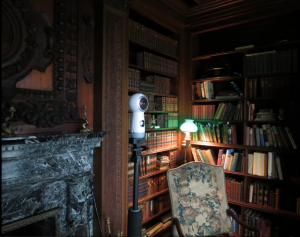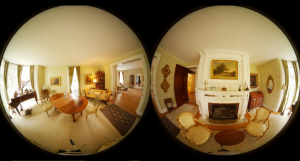As the homepage of my Omeka site states, the overall goal of Historical Homestead is to utilize “virtual representations of the objects and rooms of the Wadsworth Homestead” to ” illustrate a larger connection between the Wadsworth family and Geneseo, Livingston County, and American history.” By examining select rooms and objects within the estate, I hope to draw connections from the founding family of Geneseo to larger contexts in history.
Initially, I set out to simply create a virtual representation of the Wadsworth Homestead. I have been conducting research on the remarkable home for my ARTH 288 course, Introduction to Museum Studies, and wanted to do more with this piece. Inspired by the virtual tours I have seen on museum websites like the Frick Collection and the Uffizi Gallery, I wanted to explore this approach with the Homestead. In addition, I wanted to highlight certain objects of the Wadsworths to better tell their story. This is a common aspect in other virtual tours in museums, allowing visitors the opportunity to click and explore more about an object.

After talking with Kirk Anne, we determining that a project like this was possible, both in terms of the technology available and the time constraints. To create a virtual experience, a 360° camera would be necessary to capture the entire room. With those scenes captured, we could upload them and configure their layout to render as virtual rooms.
Designing the Site
Busy with weddings and other events, the earliest I was able to get the Homestead free of guests to begin photographing was November 1st. To be able to present something in class the week before, I began work on the Omeka site that is going to host the tour. I decided on an Omeka site, over a WordPress or other digital tools, because it is the best platform to design an exhibition about the rooms and present the 360° photos.

At first, I only did some of the basics, like choose a cover photo and font colors. As I began thinking more about the project, I designed special sections of the website to give direct access to specific rooms or objects quicker. This way, if a viewer wanted to learn more about a specific room or object without having to go through the entire virtual tour, they could easily access everything in these two sections.
Recently, I began experimenting with the HTML of the homepage text, and was able to change several aspects of it successfully.
Developing a Theme

Courtesy of WadsworthHomestead.com
During our preliminary talks, Will Wadsworth expressed great interest in the project, with one reservation. The owner of the Homestead was worried that if a virtual tour of his home was published online for the public, tour groups would stop coming and the estate would lose a major source of revenue. I reassured him that nothing would be published publicly without his consent, and began research into the pros and cons of a virtual tour for museums.
Unfortunately, I was unable to find an abundance of literature about the issue. To remedy this situation, I decided to narrow the focus of the site as a means of solving this problem. As a result, the goal of the project has become to illustrate connections between the Wadsworths and larger contexts by highlighting certain rooms in the estate. Through this narrowed lens I am able to leaving other rooms private. So, instead of creating just a “virtual homestead” as initially thought, I would argue this point of a larger connection though highlighting three select rooms and objects. Thus, I can still create a virtual tour of part of the house without feeling like I left certain aspects out, and Will does not feel tours will stop just from this sneak preview of the home. This solution is sufficient to both better arguing my point, while keeping enough of the Homestead away from the public’s screens that there will be no loss of interest to visit.
Shooting Begins
On November 1st, Kirk and I met Will at the Homestead to begin photographing. Both Will and I were surprised as to how easy the camera, a Samsung Gear 360, was to use. I simply set it up on a tripod in the middle of a room, moved out of the way (usually behind a door or in another room), and triggered the camera remotely via Kirk’s phone. From his phone, the three of us were able to view the photos in real time, and get a sense of what they would look like rendered on the Omeka site.

We photographed every room on the first and second floor, often multiple times and from various view points. By that afternoon, Kirk had uploaded the images and sent them to me for viewing. The photos, as of now, are rendered as these circular photos, resulting from the two lenses of the Samsung camera. Kirk is working now to “bend” them into rectangular panoramas, for better viewing on the Omeka site. This hopefully will be done by this week.


Traditional Humanities
Overall, I am pleased with how the project is coming along. The question still remains of whether we are going to put this site publicly on the web. Will Wadsworth wants to use these 360° photographs we have produced to show the estate to wedding planners and potential guests. Kirk Anne will be using these photographs as examples to put forth funding for anther 360° camera. So even if we never go public, I am glad that this project will be used by others outside of my specific aims for it. I wish that I had started photographing earlier, to leave myself more time to fully develop the Omeka site and everything, but I am not too worried. The next step, which is currently underway, is to decide what objects and rooms to highlight. I took note of important pieces, such as the Big Tree painting, a sculpture of Austin Wadsworth’s horse, Persian armor, and James Wadsworth’s Civil War sword, all of which are potential pieces I can use to present the Wadsworths in a wider context of history. Once the images are rendered as panoramas, and easier to view on the Omeka site, then final selections will be made.
Narrowing my focus, from a whole-house virtual experience to using a select number of rooms and objects to illustrate connections, has created a great project and connected my digital work with more traditional humanities work. Like a typical historical essay, I will be arguing a point using historical evidence and facts. The digital twist comes when the viewers of the site are able to interact with the house and historical objects that I use as evidence in my argument. Thus, I am performing traditional humanities work in a digital environment.

